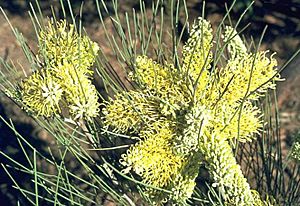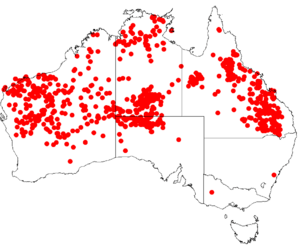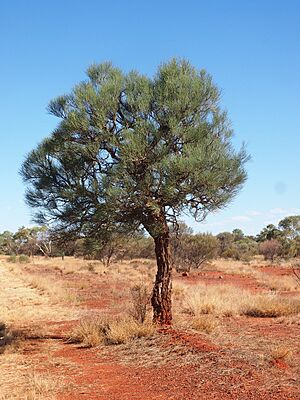Bootlace oak facts for kids
Quick facts for kids Bootlace oak |
|
|---|---|
 |
|
| Hakea lorea growing near Gascoyne Junction | |
| Scientific classification | |
| Genus: |
Hakea
|
| Species: |
lorea
|
 |
|
| Occurrence data from AVH | |
Hakea lorea, also known as the bootlace oak or cork tree, is a type of plant that grows as a shrub or small tree. You can find it in the middle and northern parts of Australia. This plant is known for its long, needle-shaped leaves, pretty yellow, white, or green flowers, and its tough, corky bark. It belongs to the Proteaceae plant family.
What it Looks Like
The Hakea lorea can grow in different ways. It might be a twisted tree up to 10 meters (about 33 feet) tall. Or, it could be a smaller shrub, usually between 1 to 5 meters (3 to 16 feet) tall. It has a special woody swelling at its base called a lignotuber. This helps the plant regrow after a fire.
Its young branches and leaves are covered with soft, silky hairs. These hairs eventually fall off, leaving the branches smooth. The trunk of the tree has thick, cork-like bark with many deep grooves.
The leaves are shaped like needles. They can be single or split into two parts. They are quite long, from 15 to 70 centimeters (6 to 27 inches) in length, but very thin, only 1 to 2.5 millimeters (about 0.04 to 0.1 inches) wide. They can stand upright or hang down.
The flowers grow in clusters, with anywhere from 15 to 200 small flowers together. These flowers can be yellow, white, or green. They usually bloom from April to September. The main stem of the flower cluster, called the rachis, is often 5 to 25 centimeters (2 to 10 inches) long and covered in soft hairs. The flowers themselves are small, and the part that holds the seeds (the pistil) is also covered in soft hairs.
After flowering, the plant produces hard fruits. These fruits are 2.5 to 5.4 centimeters (1 to 2.1 inches) long and 0.9 to 2.8 centimeters (0.35 to 1.1 inches) wide. They have a long, curved, pointed tip that looks like a beak.
Plant Name and History
The Hakea lorea was first described by a botanist named Robert Brown in 1810. He first called it Grevillea lorea. Later, in 1830, he changed its name to Hakea lorea, placing it in the Hakea group.
The name lorea comes from a Latin word meaning "made from thin strips of leather." This name was chosen because of the plant's long, thin leaves.
Hakea lorea belongs to a group of similar plants called the "corkbarks." Most of these plants live in the dry, inner parts of Australia. Scientists have found that some other Hakea species, like H. suberea and H. cunninghamii, are actually just variations of H. lorea.
There are two main types, or subspecies, of Hakea lorea:
- The main subspecies, lorea, is found across much of central and northern Australia.
- The subspecies borealis is found in the Kimberley region and the northern part of the Northern Territory.
Where it Grows
The cork tree grows across the dry interior of central and northern Australia. You can find it from the southern part of the Cape York Peninsula in Queensland, down to the Darling Downs in the southeast. It also grows in northern South Australia and the Pilbara region in Western Australia.
This plant grows slowly but is quite attractive. Its unique leaves and bark make it stand out. If you want to grow it, it needs plenty of sunshine and soil that drains water well.


